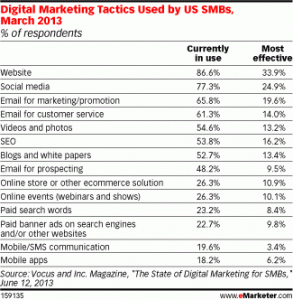According to eMarketer, social media marketing is the 2nd most popular digital marketing tactic for SMBs. With so much time and resources going into social media, it's critical that SMB marketers have a smart strategy and plan in place. Here are 7 key steps that will ensure your small business social media marketing program is a success.
1. Set smart social media goals.
The very first thing you should do is to write down your goals. What do you hope to accomplish with social media: are you looking for awareness, loyalty, sales? Whatever you decide, this will drive your presence online.
2. Determine where your audience is.
Next you need to figure out where your audience is (as in, where do they hang out online). Use that to decide in which channels you will maintain your presence. There are of course many sites to consider and all have unique advantages.
3. Define what success looks like.
Make sure you know what success will look like for you. Are you after Facebook Likes (bad strategy), or are you looking to spread awareness of articles that you or your company authors? Whatever it is, understand what you want to have happen. RELATED CLASS: What to Measure in Social & Why
4. Create an editorial calendar.
Once you’ve decided where you want to have a presence, you should develop an editorial calendar to keep topics you want to write about and post organized by site. This will also help ensure you are posting with sufficient frequency. If you have nothing of interest to post, it’s best not to post anything that hour/day/week. Make sure that the content you are going to share is relevant to your audience. You want your customers to come back to visit you, but if your content is not interesting to them, they’ll have no reason to return. Remember that content does not necessarily translate well to different social media sites, so make sure you are creating your pieces knowing where they will appear. If you have a visual product, perhaps your audience would react best to pictures. Pinterest, Facebook and Instagram may be good choices for you if that’s the case. Also decide who is responsible for writing the content and make sure everyone agrees to the time table.
5. Setup a social media policy.
It’s important to have a social media policy for your employees. This policy should be a part of your overall employee policy document and cover things like: code of conduct for your company, roles and responsibilities of employees who will be posting, who can post on behalf of the company, company policies such as the treatment of confidential information, external laws if appropriate, and best practices for online behavior. You’ll want a lawyer to review your policy to make sure all is good. Here’s an example of a well-written social media policy by Coca Cola.
6. Create a plan for handling negative feedback.
Be prepared to hear negative comments from customers. Have a plan for how you’ll handle these. Everyone hears negative comments. The key is to have a plan for dealing with them. RELATED CLASS: Crisis Management with Social Media
7. Have a plan for monitoring conversations.
Make sure to create a plan for monitoring conversations and activity. Are you going to do it yourself, or do you need a product like Hootsuite to help you monitor conversations across various networks? Social media is not a ‘set it and forget it’ tool.
Learn how to effectively use social media marketing to grow your small business.
Watch Social Media Best Practices for SMBs, and get expert advice for creating an effective and efficient social media program. Discover the best tools for social media management and monitoring, how to identify the right people to connect with, and how to get the most out of your social media efforts. Get instant access to this class now.
